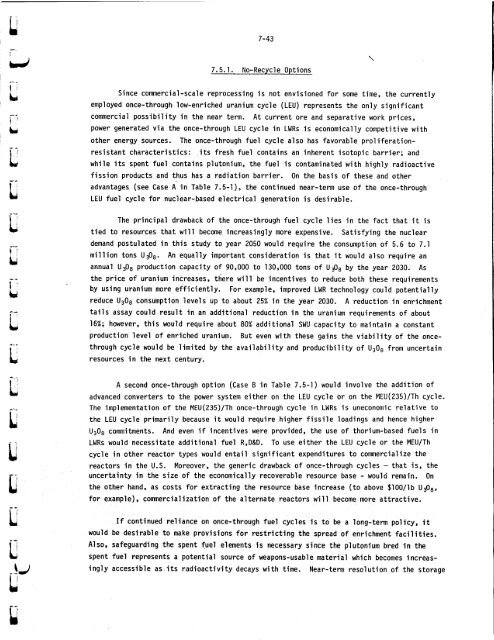ORNL-5388 - the Molten Salt Energy Technologies Web Site
ORNL-5388 - the Molten Salt Energy Technologies Web Site
ORNL-5388 - the Molten Salt Energy Technologies Web Site
Create successful ePaper yourself
Turn your PDF publications into a flip-book with our unique Google optimized e-Paper software.
e-. .<br />
!<br />
hr<br />
L3<br />
z<br />
i-<br />
b:<br />
i-<br />
b<br />
L<br />
c<br />
i<br />
li<br />
i]:<br />
II'<br />
7-43<br />
7.5.1. No-Recycle Options<br />
Since commercial-scale reprocessing is not envisioned for some time, <strong>the</strong> currently<br />
employed once-through low-enriched uranium cycle (LEU) represents <strong>the</strong> only significant<br />
commercial possibility in <strong>the</strong> near term. At current ore and separative work prices,<br />
power generated via <strong>the</strong> once-through LEU cycle in LWRs is economically competitive with<br />
o<strong>the</strong>r energy sources. The once-through fuel cycle also has favorable proliferation-<br />
resistant characteristics:<br />
while its spent fuel contains plutonium, <strong>the</strong> fuel is contaminated with highly radioactive<br />
fission products and thus has a radiation barrier.<br />
its fresh fuel contains an inherent isotopic barrier; and<br />
advantages (see Case A i n Table 7.5-l), <strong>the</strong> continued near-term use of <strong>the</strong> once-through<br />
LEU fuel cycle for nuclear-based electrical generation is desirable.<br />
On <strong>the</strong> basis of <strong>the</strong>se and o<strong>the</strong>r<br />
The principal drawback of <strong>the</strong> once-through fuel cycle lies in <strong>the</strong> fact that it is<br />
tied to resources that will become increasingly more expensive. Satisfying <strong>the</strong> nuclear<br />
demand postulated in this study to year 2050 would require <strong>the</strong> consumption of 5.6 to 7.1<br />
million tons u@8. An equally important consideration is that it would also require an<br />
annual U& production capacity of 90,000 to 130,000 tons of U$I8 by <strong>the</strong> year 2030. As<br />
<strong>the</strong> price of uranium increases, <strong>the</strong>re will be incentives to reduce both <strong>the</strong>se requirements<br />
by using uranium more efficiently. For example, improved LWR technology could potentially<br />
reduce U308 consumption levels up to about 25% in <strong>the</strong> year 2030. A reduction in enrichment<br />
tails assay could result in an additional reduction in <strong>the</strong> uranium requirements of about<br />
16%; however, this would require about 80% additional SWU capacity to maintain a constant<br />
production level of enriched uranium. But even with <strong>the</strong>se gains <strong>the</strong> viability of <strong>the</strong> once-<br />
through cycle would be limited by <strong>the</strong> availability and producibility of U308 from uncertain<br />
resources in <strong>the</strong> next century.<br />
A second once-through option (Case B in Table 7.5-1) would involve <strong>the</strong> addition of<br />
advanced converters to <strong>the</strong> power system ei<strong>the</strong>r on <strong>the</strong> LEU cycle or on <strong>the</strong> MEU(235)/Th cycle.<br />
The implementation of <strong>the</strong> MEU(235)/Th once-through cycle in LWRs is uneconomic relative to<br />
<strong>the</strong> LEU cycle primarily because it would require higher fissile loadings and hence higher<br />
U308 commitments. And even if incentives were provided, <strong>the</strong> use of thorium-based fuels in<br />
LWRs would necessitate additional fuel R,D&D. To use ei<strong>the</strong>r <strong>the</strong> LEU cycle or <strong>the</strong> MEU/Th<br />
cycle in o<strong>the</strong>r reactor types would entail significant expenditures to commercialize <strong>the</strong><br />
reactors in <strong>the</strong> U.S. Moreover, <strong>the</strong> generic drawback of once-through cycles - that is, <strong>the</strong><br />
uncertainty in <strong>the</strong> size of <strong>the</strong> economically recoverable resource base - woula remain. On<br />
<strong>the</strong> o<strong>the</strong>r hand, as costs for extracting <strong>the</strong> resource base increase (to above $100/lb u&y<br />
for example), comnercialization of <strong>the</strong> alternate reactors will become more attractive.<br />
If continued reliance on once-through fuel cycles is to be a long-term policy, it<br />
would be desirable to make provisions for restricting <strong>the</strong> spread of enrichment facilities.<br />
Also, safeguarding <strong>the</strong> spent fuel elements is necessary since <strong>the</strong> plutonium bred in <strong>the</strong><br />
spent fuel represents a potential source of weapons-usable material which becomes i ncreas-<br />
ingly accessible as its radioactivity decays with time. Near-term resolution of <strong>the</strong> storage<br />
\



![Review of Molten Salt Reactor Physics Calculations [Disc 2]](https://img.yumpu.com/21979492/1/190x247/review-of-molten-salt-reactor-physics-calculations-disc-2.jpg?quality=85)












